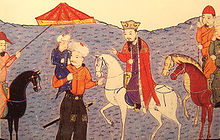Buddhism in Iran

Buddhism in Iran dates back to the 2nd century, when Parthian Buddhist missionaries, such as An Shigao and An Xuan, were active in spreading Buddhism in China. Many of the earliest translators of Buddhist literature into Chinese were from Parthia and other kingdoms linked with present-day Iran.[1]
History[]
Pre-Islamic Iran[]
Buddhists were persecuted during the Sasanid rule in the vast territory they ruled, as they made Zoroastrianism the state religion in 224 AD, and thereafter burned many Buddhist sites in the regions where it was practiced, namely Central Asia. Surviving Buddhist sites in the easternmost Sassanian territories, comprising modern day Central Asia, were later raided in the 5th century by the White Huns.[2]
Arab conquests and decline[]
"In the centuries before the Arab conquests Buddhism was spread throughout the eastern Iranian world. Buddhist sites have been found in Afghanistan, Turkmenistan, Uzbekistan, and Tajikistan, as well as within Iran itself."[3] The Arab conquests brought the final demise of Buddhism in Eastern Iran and Afghanistan, although in some sites like Bamiyan and Hadda it survived until the 8th or 9th century.[2]
Ilkhanate[]
Ilkhanate under Hulagu Khan embraced Kagyu school of Tibetan Buddhism[4] while tolerant to religious diversity, which enabled Buddhism to remain the official religion of the empire till 1295. Later, Ilkhanate ruler Ghazan, who was raised as Nestorian Christian and received Buddhist education in his youth, converted to Islam in 1295 AD and made it the state religion of the Ilkhanate.[5] He also prohibited the practice of Buddhism, but allowed monks to go into exile into neighboring Buddhist regions.[6]
Contemporary[]
In 2002, 19 Gandharan style Buddhist statues were unearthed in the southern Iranian province of Fars.[7]
In recent years, as part of the post-revolution period, Buddhist ideas and practice, as part of a broader reemergence of various faiths in Iran, has experienced an upsurge of interest among Iranians. Some of the poetry of Sohrab Sepehri shows Buddhist influence.[8]
See also[]
- An Shigao
- An Xuan
- Buddhism in Central Asia
- Buddhism in Afghanistan
- Hinduism in Iran
- Sikhism in Iran
- Ugraparipṛcchā Sūtra
Further reading[]
- Mostafa Vaziri (2012). Buddhism in Iran: An Anthropological Approach to Traces and Influences. Palgrave Macmillan. ISBN 9781137022936.
References[]
- ^ Willemen, Charles; Dessein, Bart; Cox, Collett; Gonda, Jan; Bronkhorst, Johannes; Spuler, Bertold; Altenmüller, Hartwig, Handbuch der Orientalistik: Sarvāstivāda Buddhist Scholasticism, Brill, pp. 128–130, ISBN 978-90-04-10231-6
- ^ a b Ehsan Yarshater (1993). The Cambridge History of Iran. Cambridge University Press. pp. 956–7. ISBN 978-0-521-24693-4.
- ^ Richard Foltz, "Buddhism in the Iranian World," The Muslim World 100/2-3, 2010, pp. 204-214
- ^ Yerushalmi, Dan; Samten, Jampa. "Letters for the Khans: Six Tibetan Epistles for the Mongol Rulers Hulegu and Khubilai, and the Tibetan Lama Pagpa. Co-authored with Jampa Samten".
{{cite journal}}: Cite journal requires|journal=(help) - ^ Dunn, Ross E. (2005), The adventures of Ibn Battuta, a Muslim traveler of the fourteenth century, University of California Press, pp. 86, 161, ISBN 978-0-520-24385-9
- ^ Anna Akasoy; Charles Burnett; Ronit Yoeli-Tlalim (2011). Islam and Tibet: Interactions Along the Musk Routes. Ashgate Publishing, Ltd. pp. 10–11. ISBN 978-0-7546-6956-2.
- ^ "Statues in Iran challenge theories on Buddhism's spread". The Japan Times. 2002-05-14. Retrieved 2022-01-25.
- ^ Foltz, pp. 212-213
- Buddhism in Iran
- Buddhism by country
- Religion in Iran